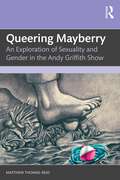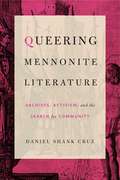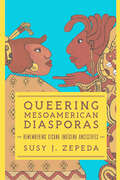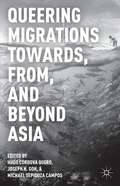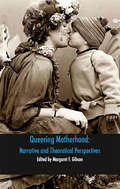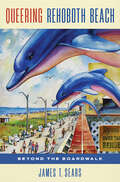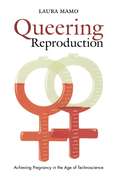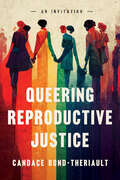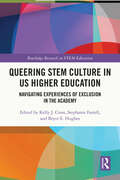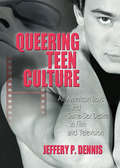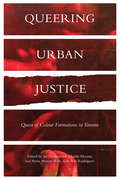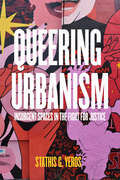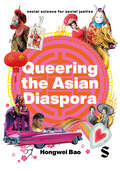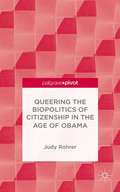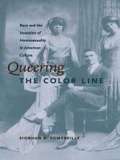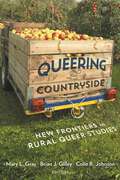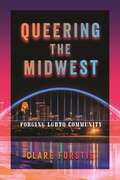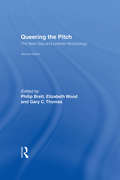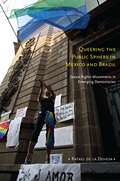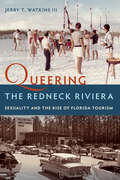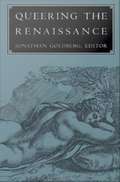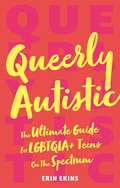- Table View
- List View
Queering Mayberry: An Exploration of Sexuality and Gender in the Andy Griffith Show
by Matthew Thomas-ReidQueering Mayberry: An Exploration of Sexuality and Gender in the Andy Griffith Show is an interdisciplinary study which reexamines The Andy Griffith Show through the frame of queer theory, offering a fresh perspective on its cultural significance in the Southern Appalachians.Amid current debates on Critical Race Theory and LGBTQIA+ rights, the nostalgic pull of the “Myth of Mayberry” remains potent. This work critiques the restorative nostalgia surrounding small-town southern ideals, arguing that disrupting the monolithic image of southern conservative, Christian, cisgender identity requires a critical look at the cultural artifacts that helped shape it. Through a combination of historical research, including original episode scripts with Andy Griffith's notes, cultural studies, and performance theory, it uncovers a complex relationship between queerness and Southern Appalachian identity.Queering Mayberry: An Exploration of Sexuality and Gender in the Andy Griffith Show will be valuable to scholars and students in Appalachian studies, media studies, queer theory, and social history.
Queering Mennonite Literature: Archives, Activism, and the Search for Community
by Daniel Shank CruzThough the terms “queer” and “Mennonite” rarely come into theoretical or cultural contact, over the last several decades writers and scholars in the United States and Canada have built a body of queer Mennonite literature that shifts these identities into conversation. In this volume, Daniel Shank Cruz brings this growing genre into a critical focus, bridging the gaps between queer theory, literary criticism, and Mennonite literature.Cruz focuses his analysis on recent Mennonite-authored literary texts that espouse queer theoretical principles, including Christina Penner’s Widows of Hamilton House, Wes Funk’s Wes Side Story, and Sofia Samatar’s Tender. These works argue for the existence of a “queer Mennonite” identity on the basis of shared values: a commitment to social justice, a rejection of binaries, the importance of creative approaches to conflict resolution, and the practice of mutual aid, especially in resisting oppression. Through his analysis, Cruz encourages those engaging with both Mennonite and queer literary criticism to explore the opportunity for conversation and overlap between the two fields.By arguing for engagement between these two identities and highlighting the aspects of Mennonitism that are inherently “queer,” Cruz gives much-needed attention to an emerging subfield of Mennonite literature. This volume makes a new and important intervention into the fields of queer theory, literary studies, Mennonite studies, and religious studies.
Queering Mennonite Literature: Archives, Activism, and the Search for Community
by Daniel Shank CruzThough the terms “queer” and “Mennonite” rarely come into theoretical or cultural contact, over the last several decades writers and scholars in the United States and Canada have built a body of queer Mennonite literature that shifts these identities into conversation. In this volume, Daniel Shank Cruz brings this growing genre into a critical focus, bridging the gaps between queer theory, literary criticism, and Mennonite literature.Cruz focuses his analysis on recent Mennonite-authored literary texts that espouse queer theoretical principles, including Christina Penner’s Widows of Hamilton House, Wes Funk’s Wes Side Story, and Sofia Samatar’s Tender. These works argue for the existence of a “queer Mennonite” identity on the basis of shared values: a commitment to social justice, a rejection of binaries, the importance of creative approaches to conflict resolution, and the practice of mutual aid, especially in resisting oppression. Through his analysis, Cruz encourages those engaging with both Mennonite and queer literary criticism to explore the opportunity for conversation and overlap between the two fields.By arguing for engagement between these two identities and highlighting the aspects of Mennonitism that are inherently “queer,” Cruz gives much-needed attention to an emerging subfield of Mennonite literature. This volume makes a new and important intervention into the fields of queer theory, literary studies, Mennonite studies, and religious studies.
Queering Mesoamerican Diasporas: Remembering Xicana Indigena Ancestries (Transformations: Womanist studies)
by Susy J. ZepedaActs of remembering offer a path to decolonization for Indigenous peoples forcibly dislocated from their culture, knowledge, and land. Susy J. Zepeda highlights the often overlooked yet intertwined legacies of Chicana feminisms and queer decolonial theory through the work of select queer Indígena cultural producers and thinkers. By tracing the ancestries and silences of gender-nonconforming people of color, she addresses colonial forms of epistemic violence and methods of transformation, in particular spirit research. Zepeda also uses archival materials, raised ceremonial altars, and analysis of decolonial artwork in conjunction with oral histories to explore the matriarchal roots of Chicana/x and Latina/x feminisms. As she shows, these feminisms are forms of knowledge that people can remember through Indigenous-centered visual narratives, cultural wisdom, and spirit practices. A fascinating exploration of hidden Indígena histories and silences, Queering Mesoamerican Diasporas blends scholarship with spirit practices to reimagine the root work, dis/connection to land, and the political decolonization of Xicana/x peoples.
Queering Migrations Towards, From, and Beyond Asia
by Hugo Córdova Quero Joseph N. Goh Michael Sepidoza CamposThe book explores migration and queerness as they relate to ethnic/racial identity constructions, immigration processes and legal status, the formation of trans/national and trans/cultural partnerships, and friendships. It explores the roles that religious identities/values/worldviews play in the fortification/critique of queer migrant identities.
Queering Motherhood: Narrative And Theoretical Perspectives
by Margaret F GibsonFew words are as steeped in beliefs about gender, sexuality, and social desirability as “motherhood”. Drawing on queer, postcolonial, and feminist theory, historical sources, personal narratives, film studies, and original empirical research, the authors in this book offer queer re-tellings and reexaminations of reproduction, family, politics, and community. The list of contributors includes emerging writers as well as established scholars and activists such as Gary Kinsman, Damien Riggs, Christa Craven, Cary Costello, Elizabeth Peel, and Rachel Epstein.
Queering Professionalism: Pitfalls and Possibilities
by Adam Davies and Cameron GreensmithWith a focus on neoliberalism and its intersection with systems of oppression, inequalities, and the regulation of queer knowledge and subjectivities, Queering Professionalism provides a distinct contribution to the emerging literature on the regulation and professionalization of 2SLGBTQIA+ individuals and others marginalized by cisheteronormativity within the “helping professions” and social services. This collection seeks to queer and disrupt ideas and understandings of the helping professions as benevolent and inherently caring by bringing together a diverse range of authors from different fields within the helping professions, such as child and youth care, education, early childhood education, dietetics, and social work. The book draws connections between neoliberalism, professionalization, structures of cisheteronormativity, and other intersecting oppressions to examine the possibilities and pitfalls of professionalism. Contributors come from various social service and helping professions to collectively critique how neoliberalism operates to silence and regulate marginalized perspectives within the various social service and education fields. By thinking with and employing queer theoretical frameworks, Queering Professionalism reimagines and disrupts neoliberal regimes that rationalize the violent conditions within and outside of helping institutions and orientations.
Queering Rehoboth Beach: Beyond the Boardwalk
by James T. Sears“Create a More Positive Rehoboth” was a decades-long goal for progress and inclusiveness in a charming beach town in southern Delaware. Rehoboth, which was established in the 19th century as a Methodist Church meeting camp, has, over time, become a thriving mecca for the LGBTQ+ community. In Queering Rehoboth Beach, historian and educator James Sears charts this significant evolution. Sears draws upon extensive oral history accounts, archival material, and personal narratives to chronicle “the Battle for Rehoboth,” which unfolded in the late 20th century, as conservative town leaders and homeowners opposed progressive entrepreneurs and gay activists. He recounts not just the emergence of the gay and lesbian bars, dance clubs, and organizations that drew the queer community to the region, but also the efforts of local politicians and homeowners, among other groups who fought to develop and protect the traditional identity of this beach town. Moreover, issues of race, class, and gender and sexuality informed opinions as residents and visitors struggled with the AIDS crisis and the legacy of Jim Crow. Queering Rehoboth Beach is more than just an inspiring story about a community’s resilience and determination to establish a safe space for itself in the wake of the era of Don’t Ask, Don’t Tell. It is also a terrific beach read.
Queering Reproduction: Achieving Pregnancy in the Age of Technoscience
by Laura MamoOriginally developed to help heterosexual couples, fertility treatments such as in vitro fertilization and sperm donation have provided lesbians with new methods for achieving pregnancy during the past two decades. Queering Reproduction is an important sociological analysis of lesbians' use of these medical fertility treatments. Drawing on in-depth interviews with lesbians who have been or are seeking to become pregnant, Laura Mamo describes how reproduction has become an intensely medicalized process for lesbians, who are transformed into fertility patients not (or not only) because of their physical conditions but because of their sexual identities. Mamo argues that this medicalization of reproduction has begun to shape queer subjectivities in both productive and troubling ways, destabilizing the assumed link between heterosexuality and parenthood while also reinforcing traditional, heteronormative ideals about motherhood and the imperative to reproduce. Mamo provides an overview of a shift within some lesbian communities from low-tech methods of self-insemination to a reliance on outside medical intervention and fertility treatments. Reflecting on the issues facing lesbians who become parents through assisted reproductive technologies, Mamo explores questions about the legal rights of co-parents, concerns about the genetic risks of choosing an anonymous sperm donor, and the ways decisions to become parents affect sexual and political identities. In doing so, she investigates how lesbians navigate the medical system with its requisite range of fertility treatments, diagnostic categories, and treatment trajectories. Combining moving narratives and insightful analysis, Queering Reproduction reveals how medical technology reconfigures social formations, individual subjectivity, and notions of kinship.
Queering Reproductive Justice: An Invitation
by Candace Bond-TheriaultThe futures of reproductive justice and LGBTQIA+ liberation are intimately connected. Both movements were born out of the desire to love and build families of our choosing—when and how we decide. Both movements are rooted in broader social justice liberationist traditions that center the needs of Black and brown communities, the LGBTQIA+ community, gender-nonconforming folks, femmes, poor folks, parents, and all those who have been forced to the margins of society. Taking as its starting point the idea that we all have the human right to bodily autonomy, to sexual health and pleasure, and to exercise these rights with dignity, Queering Reproductive Justice sets out to re-envision the seemingly disparate strands of the reproductive justice and LGBTQIA+ movements and offer an invitation to reimagine these movements as one integrated vision of freedom for the future. Candace Bond-Theriault asserts that for reproductive justice to be truly successful, we must acknowledge that members of the LGBTQIA+ community often face distinct, specific, and interlocking oppressions when it comes to these rights. Family formation, contraception needs, and appropriate support from healthcare services are still poorly understood aspects of the LGBTQIA+ experience, which often challenge mainstream notions of the nuclear family, and the primacy of blood-relatives. Blending advocacy with a legal, rights-based framework, Queering Reproductive Justice offers a unified path for attaining reproductive justice for LGBTQIA+ people. Drawing on U.S. law and legislative history, healthcare policy, human rights, and interviews with academics and activists, Bond-Theriault presents incisive new recommendations for queer reproductive justice theory, organizing, and advocacy. This book offers readers an invitation to join the conversation, and ultimately to join the movement to that is unapologetically queering reproductive justice.
Queering STEM Culture in US Higher Education: Navigating Experiences of Exclusion in the Academy (Routledge Research in STEM Education)
by Kelly J. CrossAdopting an intersectional lens, this timely volume explores the lived experiences of members of the queer and trans community in post-secondary STEM culture in the US to provide critical insights into progressing socially just STEM education pathways. Offering contributions from students, faculty, practitioners, and administrators, the volume highlights prevailing issues of heteronormativity and marginalization across a range of STEM disciplines. Autoethnographic accounts place minority experiences within the broader context of social and cultural phenomena to reveal subtle and overt forms of exclusion, and systematic barriers to participation in STEM professions, academia, and research. Finally, the book offers key recommendations to inform future research and practice. This volume will benefit researchers, academics, and educators with an interest in higher education, engineering education, and the sociology of education more broadly. Those involved with diversity, equity, and inclusion within education, queer theory, and gender and sexuality studies will also benefit from this volume.
Queering Teen Culture: All-American Boys and Same-Sex Desire in Film and Television
by Jeffery P DennisWhy did Fonzie hang around with all those high school boys?Is the overwhelming boy-meets-girl content of popular teen movies, music, books, and TV just a cover for an undercurrent of same-sex desire? From the 1950s to the present, popular culture has involved teenage boys falling for, longing over, dreaming about, singing to, and fighting over, teenage girls. But Queering Teen Culture analyzes more than 200 movies and TV shows to uncover who Frankie Avalon&’s character was really in love with in those beach movies and why Leif Garrett became a teen idol in the 1970s. In Top 40 songs, teen magazines, movies, TV soap operas and sitcoms, teenagers are defined by their pubescent "discovery" of the opposite sex, universally and without exception. Queering Teen Culture looks beyond the litany to find out when adults became so insistent about teenage sexual desire-and why-and finds evidence of same-sex desire, romantic interactions, and identities that, according to the dominant ideology, do not and cannot exist. This provocative book examines the careers of male performers whose teenage roles made them famous (including Ricky Nelson, Pat Boone, Fabian, and James Darren) and discusses examples of lesbian desire (including I Love Lucy and Laverne and Shirley). Queering Teen Culture examines: Ozzie and Harriet, Father Knows Best, and Leave It to Beaver: Were Ricky, Bud, and Wally sufficiently straight? the juvenile delinquent films of the 1950s: Why weren&’t the rebel-without-a-cause "bad boys" interested in girls? horror, sci-fi, and zombies from outer space: "Body of a boy! Mind of a monster! Soul of an unearthly thing!" teen idols-pretty, androgynous, and feminine: No wonder they were rumored to be "funny" beach movies: She wants to plan their wedding but he wants to surf, sky-dive and go drag racing with the guys Biker-hippies boys of the late 1960s: "I know your scene-don&’t think I don&’t!" the 1950s nostalgia of the 1970s: Why does Fonzie spend all his time with high school boys? teen gore: What makes the psycho-killer angry? and much more, including Gidget, the Brat Pack, buddy dramas, nerds and "operators," Saved by the Bell, The Real World, and the incredible shrinking teenager Queering Teen Culture is an essential read for academics working in cultural and gay studies, and for anyone else with an interest in popular culture.
Queering Urban Justice: Queer of Colour Formations in Toronto
by Jinthana Haritaworn Ghaida Moussa Syrus Marcus Ware Gabriela Rio RodriguezQueering Urban Justice foregrounds visions of urban justice that are critical of racial and colonial capitalism, and asks: What would it mean to map space in ways that address very real histories of displacement and erasure? What would it mean to regard Queer, Trans, Black, Indigenous, and People of Colour (QTBIPOC) as geographic subjects who model different ways of inhabiting and sharing space? The volume describes city spaces as sites where bodies are exhaustively documented while others barely register as subjects. The editors and contributors interrogate the forces that have allowed QTBIPOC to be imagined as absent from the very spaces they have long invested in. From the violent displacement of poor, disabled, racialized, and sexualized bodies from Toronto’s gay village, to the erasure of queer racialized bodies in the academy, Queering Urban Justice offers new directions to all who are interested in acting on the intersections of social, racial, economic, urban, migrant, and disability justice.
Queering Urbanism: Insurgent Spaces in the Fight for Justice
by Stathis G. YerosA free ebook version of this title is available through Luminos, University of California Press’s Open Access publishing program. Visit www.luminosoa.org to learn more. Conflicts about space and access to resources have shaped queer histories from at least 1965 to the present. As spaces associated with middle-class homosexuality enter mainstream urbanity in the United States, cultural assimilation increasingly erases insurgent aspects of these social movements. This gentrification itself leads to queer displacement. Combining urban history, architectural critique, and queer and trans theories, Queering Urbanism traces these phenomena through the history of a network of sites in the San Francisco Bay Area. Within that urban landscape, Stathis Yeros investigates how queer people appropriated existing spaces, how they expressed their distinct identities through aesthetic forms, and why they mobilized the language of citizenship to shape place and secure space. Here the legacies of LGBTQ+ rights activism meet contemporary debates about the right to housing and urban life.
Queering the Asian Diaspora: East and Southeast Asian Sexuality, Identity and Cultural Politics (Social Science for Social Justice)
by Hongwei BaoThe COVID-19 pandemic has intensified global geopolitical tensions, bringing Sinophobia and anti-Asian racism into sharp focus. At the same time, a growing Asian diasporic consciousness is emerging worldwide, celebrating Asian identity and cultural heritage. Yet, in the space between anti-Asian racism and the rise of Asian advocacy, the voices of queer people have often been largely missing. This book addresses that gap. Exploring a range of contemporary case studies from art, fashion, performance, film, and political activism, Bao offers a powerful intersectional cultural politics—anti-nationalist, anti-racist, decolonial, feminist, and queer—that challenges dominant narratives and amplifies marginalized voices. The Social Science for Social Justice series challenges the Ivory Tower of academia, providing a platform for academics, journalists, and activists of color to respond to pressing social issues.
Queering the Asian Diaspora: East and Southeast Asian Sexuality, Identity and Cultural Politics (Social Science for Social Justice)
by Hongwei BaoThe COVID-19 pandemic has intensified global geopolitical tensions, bringing Sinophobia and anti-Asian racism into sharp focus. At the same time, a growing Asian diasporic consciousness is emerging worldwide, celebrating Asian identity and cultural heritage. Yet, in the space between anti-Asian racism and the rise of Asian advocacy, the voices of queer people have often been largely missing. This book addresses that gap. Exploring a range of contemporary case studies from art, fashion, performance, film, and political activism, Bao offers a powerful intersectional cultural politics—anti-nationalist, anti-racist, decolonial, feminist, and queer—that challenges dominant narratives and amplifies marginalized voices. The Social Science for Social Justice series challenges the Ivory Tower of academia, providing a platform for academics, journalists, and activists of color to respond to pressing social issues.
Queering the Biopolitics of Citizenship in the Age of Obama
by Judy RohrerWhere dominant citizenship narratives have heretofore focused on either the state or the nation as qualifiers of belonging, this book draws from the interdisciplinary fields of queer theory, critical race theory, feminist political theory, disability studies, and indigenous studies to further an evolving discussion of what it means to be an American citizen in the Obama era. Rohrer demonstrates that this discussion requires an understanding of the machinations of governmentality and biopolitics in the (re)production of the (proper) citizen.
Queering the Color Line: Race and the Invention of Homosexuality in American Culture
by Siobhan B. SomervilleQueering the Color Line transforms previous understandings of how homosexuality was "invented" as a category of identity in the United States beginning in the late nineteenth century. Analyzing a range of sources, including sexology texts, early cinema, and African American literature, Siobhan B. Somerville argues that the emerging understanding of homosexuality depended on the context of the black/white "color line," the dominant system of racial distinction during this period. This book thus critiques and revises tendencies to treat race and sexuality as unrelated categories of analysis, showing instead that race has historically been central to the cultural production of homosexuality. At about the same time that the 1896 Supreme Court Plessy v. Ferguson decision hardened the racialized boundary between black and white, prominent trials were drawing the public's attention to emerging categories of sexual identity. Somerville argues that these concurrent developments were not merely parallel but in fact inextricably interrelated and that the discourses of racial and sexual "deviance" were used to reinforce each other's terms. She provides original readings of such texts as Havelock Ellis's late nineteenth-century work on "sexual inversion," the 1914 film A Florida Enchantment, the novels of Pauline E. Hopkins, James Weldon Johnson's Autobiography of an Ex-Coloured Man, and Jean Toomer's fiction and autobiographical writings, including Cane. Through her analyses of these texts and her archival research, Somerville contributes to the growing body of scholarship that focuses on discovering the intersections of gender, race, and sexuality. Queering the Color Line will have broad appeal across disciplines including African American studies, gay and lesbian studies, literary criticism, cultural studies, cinema studies, and gender studies.
Queering the Countryside: New Frontiers in Rural Queer Studies (Intersections #11)
by Mary L. Gray Brian J. Gilley Colin R. JohnsonChoice Outstanding Academic Title of 2016Rural queer experience is often hidden or ignored, and presumed to be alienating, lacking, and incomplete without connections to a gay culture that exists in an urban elsewhere. Queering the Countryside offers the first comprehensive look at queer desires found in rural America from a genuinely multi-disciplinary perspective. This collection of original essays confronts the assumption that queer desires depend upon urban life for meaning.By considering rural queer life, the contributors challenge readers to explore queer experiences in ways that give greater context and texture to modern practices of identity formation. The book’s focus on understudied rural spaces throws into relief the overemphasis of urban locations and structures in the current political and theoretical work on queer sexualities and genders. Queering the Countryside highlights the need to rethink notions of “the closet” and “coming out” and the characterizations of non-urban sexualities and genders as “isolated” and in need of “outreach.” Contributors focus on a range of topics—some obvious, some delightfully unexpected—from the legacy of Matthew Shepard, to how heterosexuality is reproduced at the 4-H Club, to a look at sexual encounters at a truck stop, to a queer reading of TheWizard of Oz.A journey into an unexplored slice of life in rural America, Queering the Countryside offers a unique perspective on queer experience in the modern United States and Canada.
Queering the Midwest: Forging LGBTQ Community
by Clare ForstieHow LGBTQ community life in a small Midwestern city differs from that in larger cities with established gayborhoodsRiver City is a small, Midwestern, postindustrial city surrounded by green hills and farmland with a population of just over 50,000. Most River City residents are white, working-class Catholics, a demographic associated with conservative sexual politics. Yet LGBTQ residents of River City describe it as a progressive, welcoming, and safe space, with active LGBTQ youth groups and regular drag shows that test the capacity of bars.In this compelling examination of LGBTQ communities in seemingly “unfriendly” places, Queering the Midwest highlights the ambivalence of LGBTQ lives in the rural Midwest, where LGBTQ organizations and events occur occasionally but are generally not grounded in long-standing LGBTQ institutions. Drawing on in-depth interviews and ethnographic observation, Clare Forstie offers the story of a community that does not fit neatly into a narrative of progress or decline. Rather, this book reveals the contradictions of River City’s LGBTQ community, where people feel both safe and unnoticed, have a sense of belonging and persistent marginalization, and have friendships that do and don’t matter. These “ambivalent communities” in small Midwestern cities challenge the ways we think about LGBTQ communities and relationships and push us to embrace the contradictions, failures, and possibilities of LGBTQ communities across the American Midwest.
Queering the Pitch: The New Gay And Lesbian Musicology
by Elizabeth Wood Philip Brett Gary C. ThomasWhen the first edition of Queering the Pitch was published in early 1994, it was immediately hailed as a landmark and defining work in the new field of Gay Musicology. In light of the explosion of Gay Musicology since 1994, a new edition of Queering the Pitch is timely and needed. In this new work, the editors are including a landmark essay by Philip Brett on Gay Musicology, its history and scope. The essay itself has become a cause celebre, and this will be its first full appearance in print. Along with this new historical essay, the editors are contributing a new introduction that outlines the changes that have occurred over the last decade as Gay Musicology has grown.
Queering the Public Sphere in Mexico and Brazil: Sexual Rights Movements in Emerging Democracies
by Rafael de la DehesaQueering the Public Sphere in Mexico and Brazil is a groundbreaking comparative analysis of the historical development and contemporary dynamics of LGBT activism in Latin America's two largest democracies. Rafael de la Dehesa focuses on the ways that LGBT activists have engaged with the state, particularly in alliance with political parties and through government health agencies in the wake of the AIDS crisis. He examines this engagement against the backdrop of the broader political transitions to democracy, the neoliberal transformation of state-civil society relations, and the gradual consolidation of sexual rights at the international level. His comparison highlights similarities between sexual rights movements in Mexico and Brazil, including a convergence on legislative priorities such as antidiscrimination laws and the legal recognition of same-sex couples. At the same time, de la Dehesa points to notable differences in the tactics deployed by activists and the coalitions brought to bear on the state. De la Dehesa studied the archives of activists, social-movement organizations, political parties, religious institutions, legislatures, and state agencies, and he interviewed hundreds of individuals, not only LGBT activists, but also feminists, AIDS and human-rights activists, party militants, journalists, academics, and state officials. He marshals his prodigious research to reveal the interplay between evolving representative institutions and LGBT activists' entry into the political public sphere in Latin America, offering a critical analysis of the possibilities opened by emerging democratic arrangements, as well as their limitations. At the same time, exploring activists' engagement with the international arena, he offers new insights into the diffusion and expression of transnational norms inscribing sexual rights within a broader project of liberal modernity. Queering the Public Sphere in Mexico and Brazil is a landmark examination of LGBT political mobilization.
Queering the Redneck Riviera: Sexuality and the Rise of Florida Tourism
by Jerry T. Watkins IIIQueering the Redneck Riviera recovers the forgotten and erased history of gay men and lesbians in North Florida, a region often overlooked in the story of the LGBTQ experience in the United States. Jerry Watkins reveals both the challenges these men and women faced in the years following World War II and the essential role they played in making the Emerald Coast a major tourist destination. In a state dedicated to selling an image of itself as a “family-friendly” tropical paradise and in an era of increasing moral panic and repression, queer people were forced to negotiate their identities and their places in society. Watkins re-creates queer life during this period, drawing from sources including newspaper articles, advertising and public relations campaigns, oral history accounts, government documents, and interrogation transcripts from the state’s Johns Committee. He discovers that postwar improvements in transportation infrastructure made it easier for queer people to reach safe spaces to socialize. He uncovers stories of gay and lesbian beach parties, bars, and friendship networks that spanned the South. The book also includes rare photos from the Emma Jones Society, a Pensacola-based group that boldly hosted gatherings and conventions in public places. Illuminating a community that boosted Florida’s emerging tourist economy and helped establish a visible LGBTQ presence in the Sunshine State, Watkins offers new insights about the relationships between sexuality, capitalism, and conservative morality in the second half of the twentieth century.
Queering the Renaissance
by Jonathan GoldbergQueering the Renaissance offers a major reassessment of the field of Renaissance studies. Gathering essays by sixteen critics working within the perspective of gay and lesbian studies, this collection redraws the map of sexuality and gender studies in the Renaissance. Taken together, these essays move beyond limiting notions of identity politics by locating historically forms of same-sex desire that are not organized in terms of modern definitions of homosexual and heterosexual. The presence of contemporary history can be felt throughout the volume, beginning with an investigation of the uses of Renaissance precedents in the 1986 U. S. Supreme Court decision Bowers v. Hardwick, to a piece on the foundations of 'our' national imaginary, and an afterword that addresses how identity politics has shaped the work of early modern historians. The volume examines canonical and noncanonical texts, including highly coded poems of the fifteenth-century Italian poet Burchiello, a tale from Marguerite de Navarre's Heptameron, and Erasmus's letters to a young male acolyte. English texts provide a central focus, including works by Spenser, Shakespeare, Bacon, Donne, Beaumont and Fletcher, Crashaw, and Dryden. Broad suveys of the complex terrains of friendship and sodomy are explored in one essay, while another offers a cross-cultural reading of the discursive sites of lesbian desire. Accessibly written, boldly interdisciplinary, Queering the Renaissance will be indispensable for literary critics, historians, and theorists seeking to understand the representation of same-sex desire in the early modern period. Contributors. Alan Bray, Marcie Frank, Carla Freccero, Jonathan Goldberg, Janet Halley, Graham Hammill, Margaret Hunt, Donald N. Mager, Jeff Masten, Elizabeth Pittenger, Richard Rambuss, Alan K. Smith, Dorothy Stephens, Forrest Tyler Stevens, Valerie Traub, Michael Warner
Queerly Autistic: The Ultimate Guide For LGBTQIA+ Teens On The Spectrum
by Erin EkinsIn this empowering and honest guide for LGBTQIA+ autistic teens, Erin Ekins gives you all the tools you need to figure out and explore your gender identity and sexuality. From coming out to friends and family, staying safe in relationships and practicing safe sex, through to self-care and coping with bullying, being out and about in the LGBTQIA+ community and undergoing gender transition, this book is filled with essential information, advice, support and resources to help you on your journey, and also works as a primer on all things LGBTQIA+ for non-autistic teens who are just figuring it all out. Written by an inspirational autistic queer woman, this is a must-read for every autistic teen wanting to live their very best queer life.
